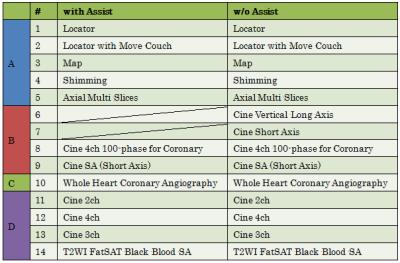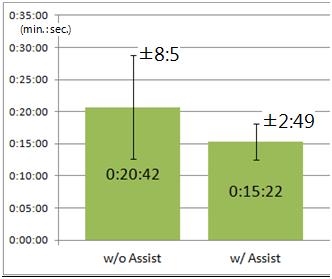4772
Workflow Improvement with a Cardiac MRI Positioning Assist Function1MRI Systems Division, Toshiba Medical Systems Corporation, Tochigi, Japan, 2Corporate Research & Development Center, Toshiba Corporation
Synopsis
In this study, we evaluated how the Cardiac MRI positioning assist function can reduce the operation steps and times in CMRI. When using the assist function, the total number of the operation steps was reduced to about 25% for both the experts and the beginners. The operation time was also reduced to about 25%. The mean and SD of the elapsed time for the CMRI procedure performed by experts were reduced from 42m17s±10m53s to 32m46s±3m29s, and those for coronary angiography were reduced from 20m42s±8m5s to 15m22s±2m49s.
Introduction and Purpose
Cardiac MR imaging (CMRI) is very useful to evaluate the structure and function of left / right ventricle, cardiac valves and coronary arteries. However, the planning of CMRI is a complex, operator-dependent, and time-consuming procedure. In addition, the diagnostic quality of the examination will be affected by the successful execution of the following steps: identifying organs such as the heart and diaphragm, aligning the heart at the magnetic center, and positioning motion probes for real-time motion correction. We have developed an automatic slice-alignment method which simultaneously detects 14 planes for ventricular and valvular analysis1, and an automatic planning assist system for couch adjustment, local shimming scan plan, axial multi-slice scan plan for automatic slice-alignment, and whole-heart coronary scan plan (the motion probes and an axial slab for main scan)2. In this study, we evaluated how the combination of the aforementioned two methods can reduce the operation steps and procedure times in CMRI.Methods
Cardiac MR imaging protocols, including left ventricular structure, function module and coronary artery evaluation module, were acquired for a population of healthy volunteers as shown in Table 1 by 2 groups of operators: 5 experts who have experience in CMRI, and 6 beginners who are not familiar with CMRI. All of the 11 operators are certified radiological technologists. The 11 operators acquired the CMRI protocols firstly without the cardiac MRI positioning assist function and secondly with the aid of the assist function. Usability was assessed by measuring (1) total number of operation steps, (2) operation time for slice positioning (3) elapsed time until completion of the CMRI procedure and (4) elapsed time until completion of the coronary angiography.Results
When using the CMRI assist application, the average number of operation steps was reduced from 291.4 to 77.0 for the experts and from 282.4 to 62.7 for the beginners as show in Figure 1. The average operation time was reduced from 14m7s to 3m31s for the experts and from 23m40s to 5m59s for the beginners as shown in Figure 2. The mean and SD of the elapsed time until completion of the CMRI procedure was reduced from 42m17s±10m53s to 32m46s±3m29s for the experts as shown in Figure 3. The mean and SD of the elapsed time until completion of the coronary angiography was reduced from 20m42s±8m5s to 15m22s±2m49s for the experts as shown in Figure 4.Discussion
When using the CMRI assist function, the total number of the operation steps was almost the same between experts and beginners as shown in Figure 1, and the number of steps was reduced to about 25% for both groups of operators. The operation time was also reduced to about 25% for both experts and beginners. In particular, the number of operation steps and time were reduced for every part of the CMRI protocol. The mean elapsed time until completion of the CMRI procedure for experts was reduced to about 78%, and its SD was reduced to about 32%. Portions B and C of the CMRI protocol (Table 1) experienced the most significant reduction, as shown in Figure 3. Acquisitions #6 and #7 in Table 1 could be removed when using the assist function because they serve as Localizers and are made unnecessary when the 4-chamber and short axis planes are calculated automatically. This of course contributes to reducing the elapsed time for part B. The mean elapsed time was reduced to about 74%, and its SD was reduced to 35% for portion C, the coronary acquisition. The assist function proved capable of setting the motion probes at the suitable location with good reproducibility, contributing to reducing the elapsed time SD for the coronary acquisition.Conclusion
The number of operation steps and the operation time were reduced to about 25% for both experts and beginners when using the CMRI assist function. The mean time and standard deviation for CMRI, including whole heart coronary angiography, were also reduced. The accuracy of positioning has been previously evaluated1,2. Using the CMRI positioning assist function, everyone can reliably plan a Cardiac MR examination with fewer operation steps and shorter times. The reduction of elapsed time SD may also allow operators to more reliably schedule CMRI procedures, and coronary examinations in particular.Acknowledgements
No acknowledgement found.References
1. S Kuhara, S Nitta, et al. Multi-ethnic evaluation of fully automatic planning assist system for cardiac magnetic resonance imaging, Journal of Cardiovascular Magnetic Resonance 2014, 16(Suppl 1):P76
2. S Nitta, T Shiodera, et al. Automatic 14-plane slice-alignment method for ventricular and valvular analysis in cardiac magnetic resonance imaging, Journal of Cardiovascular Magnetic Resonance 2014, 16(Suppl 1):P1
Figures




